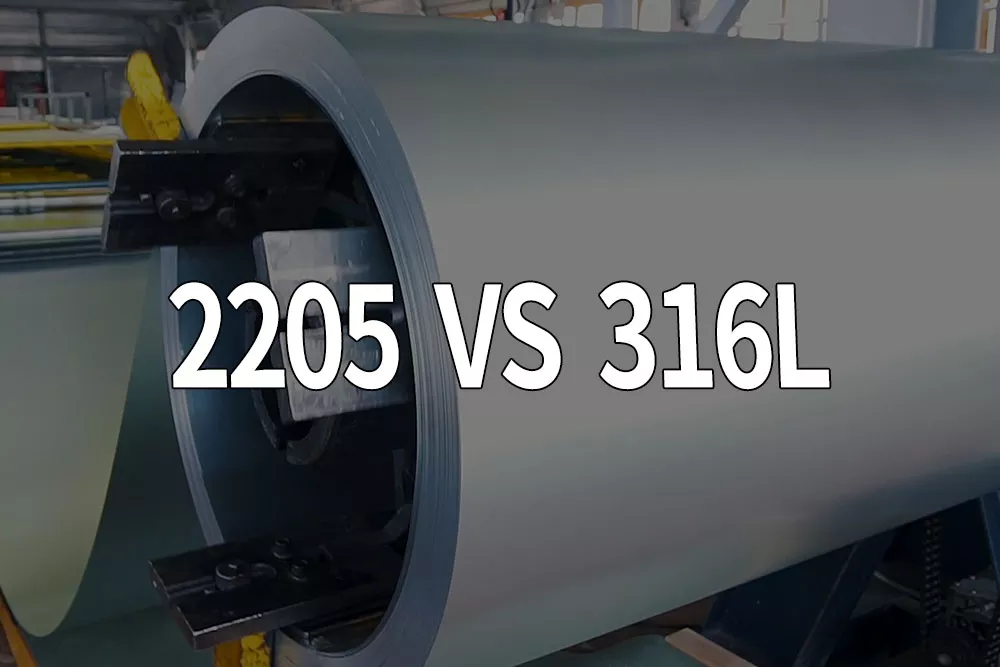2205 stainless steel and 316L stainless steel are two common corrosion-resistant stainless steels, despite their similarity in some aspects, there are significant differences in chemical composition, physical properties, corrosion resistance, mechanical properties and application areas. The following is a detailed comparison of the two:
1. chemical composition
Stainless steel 2205 is a duplex stainless steel containing both austenitic and ferritic phases, while 316L is an austenitic stainless steel. Here is a comparison of their chemical compositions:
| elemental | 2205 (% wt) | 316L (% wt) |
|---|---|---|
| Carbon (C) | ≤ 0.03 | ≤ 0.03 |
| Chromium (Cr) | 22.0 – 23.0 | 16.0 – 18.0 |
| Nickel (Ni) | 4.5 – 6.5 | 10.0 – 14.0 |
| Molybdenum (Mo) | 3.0 – 3.5 | 2.0 – 3.0 |
| Manganese (Mn) | ≤ 2.0 | ≤ 2.0 |
| Silicon (Si) | ≤ 1.0 | ≤ 0.75 |
| Nitrogen (N) | 0.14 – 0.20 | ≤ 0.10 |
| Phosphorus (P) | ≤ 0.03 | ≤ 0.045 |
| Sulfur (S) | ≤ 0.02 | ≤ 0.03 |
2. Corrosion resistance
Due to its higher chromium and molybdenum content and added nitrogen, 2205 stainless steel has greater resistance to pitting and crevice corrosion, especially in chloride-containing environments.316L also performs well in most corrosive media, but its corrosion resistance is not as good as that of 2205 in highly chloride-containing environments.
| environmental conditions | 2205 | 316L |
|---|---|---|
| Pitting Potential (mV vs SCE) | greater | relatively low |
| Critical crevice corrosion temperature (°C) | greater | relatively low |
| Applicable environment | High chloride environments | General corrosive environment |
3. mechanical property
Stainless steel 2205 has high yield and tensile strengths, which gives it an advantage in structural applications that require more strength.
| Performance Parameters | 2205 | 316L |
|---|---|---|
| Tensile Strength (MPa) | 620 – 850 | 485 |
| Yield strength (MPa) | ≥ 450 | 170 – 310 |
| Elongation (%) | ≥ 25 | ≥ 40 |
| Hardness (HB) | 290 max | 217 max |
4. physical property
Stainless steel 2205 is slightly denser than 316L, with differences in coefficient of thermal expansion and thermal conductivity.
| Performance Parameters | 2205 | 316L |
|---|---|---|
| Density (g/cm³) | 7.8 | 8.0 |
| Coefficient of thermal expansion (10-⁶/°C) | 13.0 | 16.0 |
| Thermal conductivity (W/m-K) | 19 | 16.3 |
5. weldability
The weldability of 2205 stainless steel is slightly more complex than that of 316L because of its duplex structure, which requires controlled cooling rates to avoid the formation of brittle phases. 316L is simpler to weld because of its single-phase austenitic structure and does not require heat treatment after welding.
6. Application Areas
Due to its high strength and corrosion resistance, 2205 stainless steel is commonly used in the following areas:
- Oil and gas industry, especially in environments containing high chlorides
- Marine engineering, e.g. ships, offshore platforms
- Chemical equipment and heat exchangers
316L stainless steel, on the other hand, is widely used:
- Chemical, pharmaceutical and food processing equipment
- medical equipment
- Lightweight structural components for seawater environments
7. price comparison
The market price of 2205 is generally higher than that of 316L due to the higher content of alloying elements and higher production costs.



